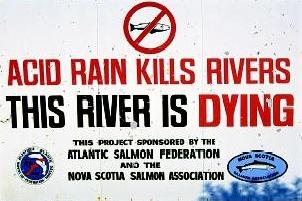Acid deposition

 8.5 Acid deposition (1 hour)
8.5 Acid deposition (1 hour)
Pause for thought
 The term 'acid rain' was first coined by Robert Smith (1817-1884) a Scottish chemist, in a book entitled 'Air and Rain: The Beginnings of a Chemical Climatology' published in 1872. Although the effect of polluting gases from the industrial revolution had been noticed even earlier than that, it was not until the 1960s that it was perceived as a serious problem. In everyday parlance 'acid rain' covers fog, snow and dew as well as rain but the IB more correctly uses the term acid deposition. Technically there is wet deposition due to acidic oxides dissolving and reacting in atmospheric water and dry deposition which covers acidic gases and particles but for this sub-topic the IB does not distinguish between these two categories of acid deposition.
The term 'acid rain' was first coined by Robert Smith (1817-1884) a Scottish chemist, in a book entitled 'Air and Rain: The Beginnings of a Chemical Climatology' published in 1872. Although the effect of polluting gases from the industrial revolution had been noticed even earlier than that, it was not until the 1960s that it was perceived as a serious problem. In everyday parlance 'acid rain' covers fog, snow and dew as well as rain but the IB more correctly uses the term acid deposition. Technically there is wet deposition due to acidic oxides dissolving and reacting in atmospheric water and dry deposition which covers acidic gases and particles but for this sub-topic the IB does not distinguish between these two categories of acid deposition.

Nature of science
Acid deposition is a good example of the risks and problems facing chemistry. Acid deposition, caused from the reactions of non-metal oxides with water, can be discussed from different perspectives. Through understanding the underlying theory, chemists are able to reduce the environmental impact of human activities.
Learning outcomesAfter studying this topic students should be able to: Understand:
Apply their knowledge to:
| Clarification notesThere are no clarification notes given for this topic as the acids concerned have already been specified in the opposite column. International-mindednessOften the country causing the pollution is different to the country receiving the pollution. Acid deposition is a secondary pollutant that affects regions that may be far from the primary source. International cooperation. is required to solve this problem. |
Teaching tipsIn many ways this is quite an easy topic to teach at this level and one which you could get students to make presentations to give to the rest of the class (see the third reference below in 'other resources'). Stress the main causes of acid 'rain' (I still call it that!) and the fact that carbonic acid is a weak acid so acid rain must have a pH of less than 5.6. Students will need all the equations for the formation of the oxides of sulfur and nitrogen and their conversion to the four acids, H2SO3, H2SO4, HNO3 and HNO2. For the effects of acid deposition talk about leaching out important nutrients from the soil, and the leaching of aluminium from rocks into the soil. The effect on aquatic life as the pH becomes lower, the increased risk of respiratory illnesses in humans and the destruction of limestone based buildings and statues with the relevant equations. Much of this information together with examples is given in the page on Topics 8 & 18 in the section on Incorporating International-mindedness, Theory of Knowledge and 'Utilization'. The methods of reducing the sources of SOx and NOx include the use of catalytic converters, improved efficiency of engine design, 'scrubbing' and fluidized bed combustion etc. etc. You should also emphasise the need to reduce our dependence upon fossil fuels and the post-combustion practice of treating acid lakes with lime to increase the pH. | Study guide
Page 62 QuestionsFor ten 'quiz' multiple choice questions with the answers explained see MC test: Acid deposition. For short-answer questions which can be set as an assignment for a test, homework or given for self study together with model answers see Acid deposition questions. Vocabulary listAcid deposition IM, TOK, Utilization etc.See separate page which covers all of Topic 8 Practical work
|
Teaching slides
Teachers may wish to share these slides with students for learning or for reviewing key concepts.
Other resources
1. The effects of acid rain on buildings in Washington D.C. by Discovery News.
2. A very simple but quite effective video on coal burning power stations and acid rain by Brittanica.com
Effect of acid rain on buildings ![]()
3. A good summary of both the causes and effects of acid precipitation by Fuse School.

 IB Docs (2) Team
IB Docs (2) Team 















